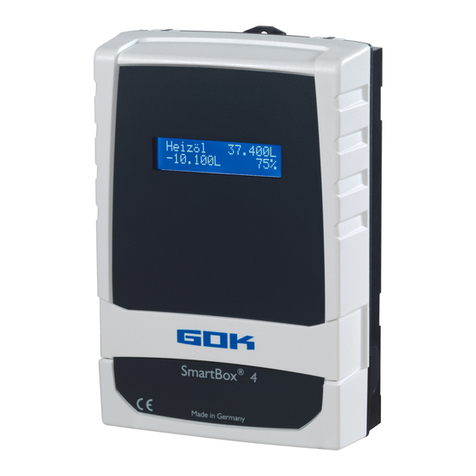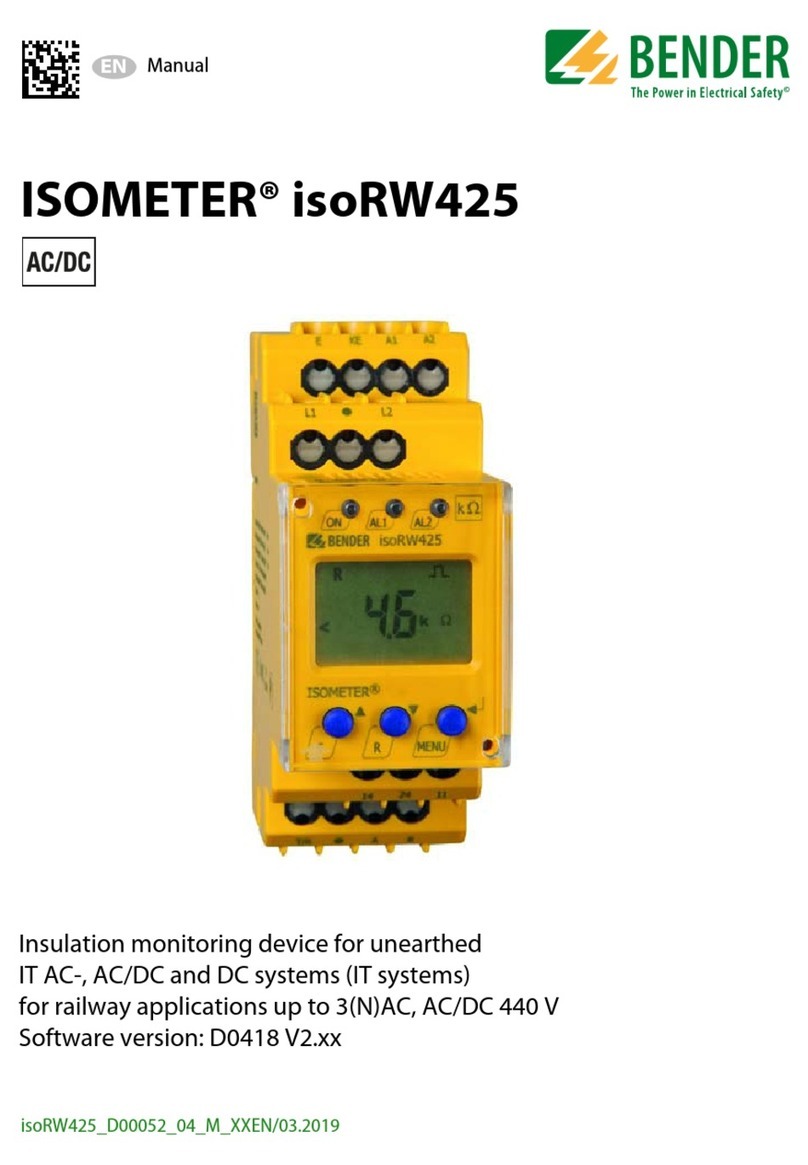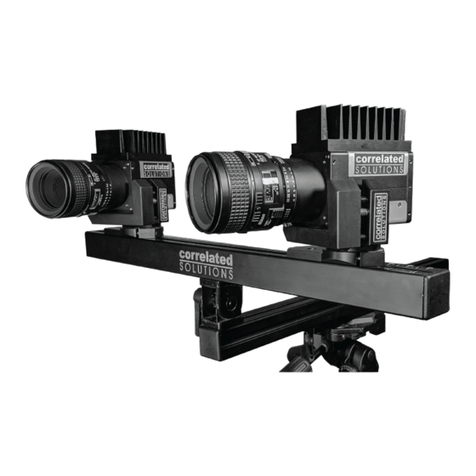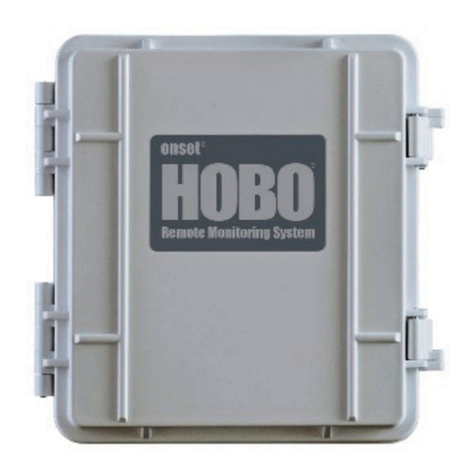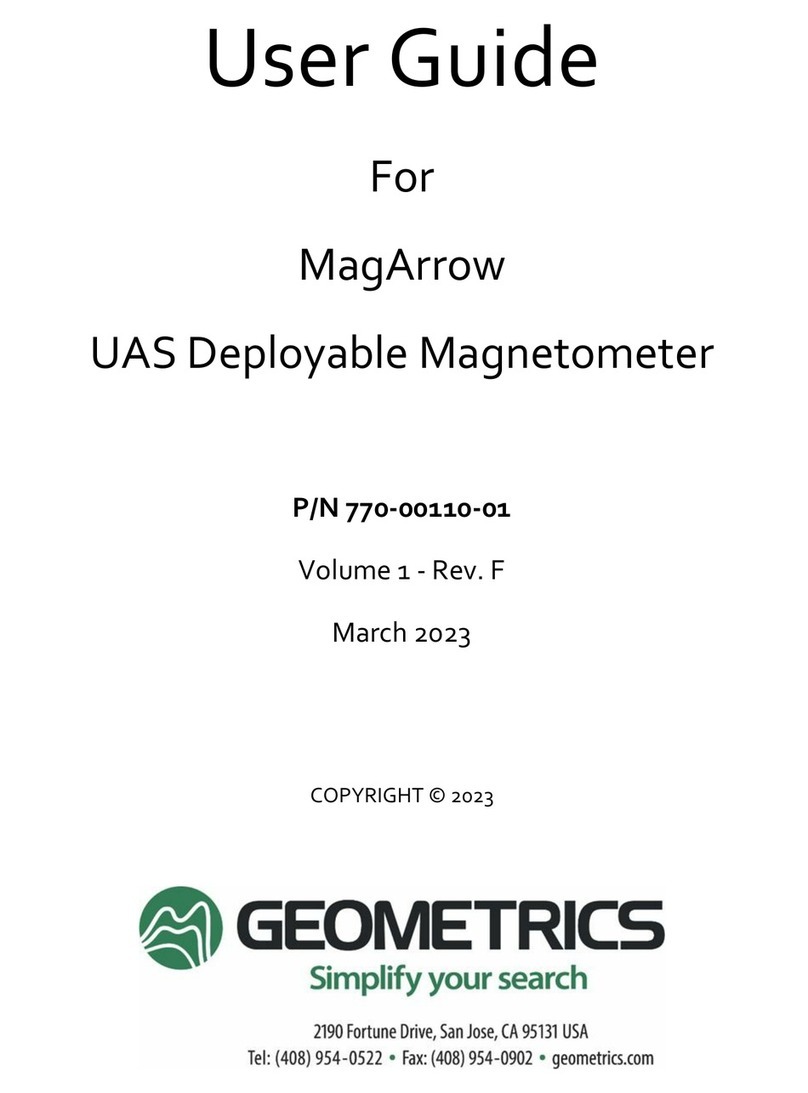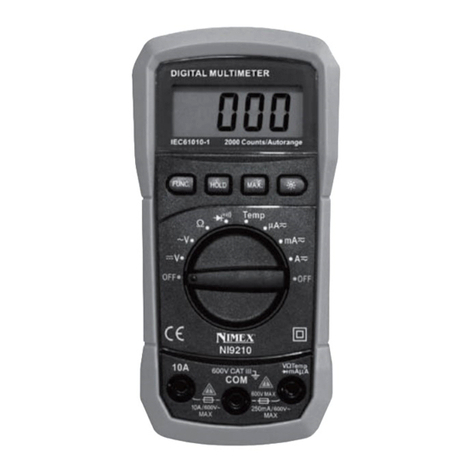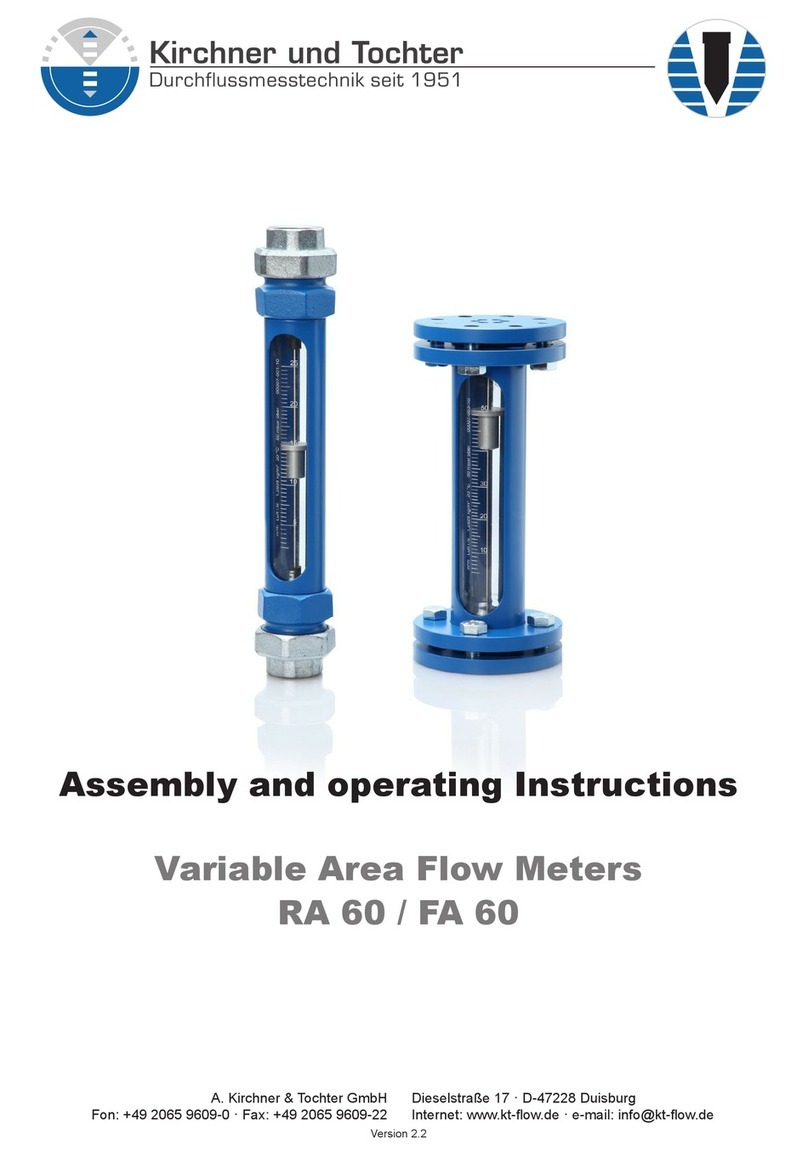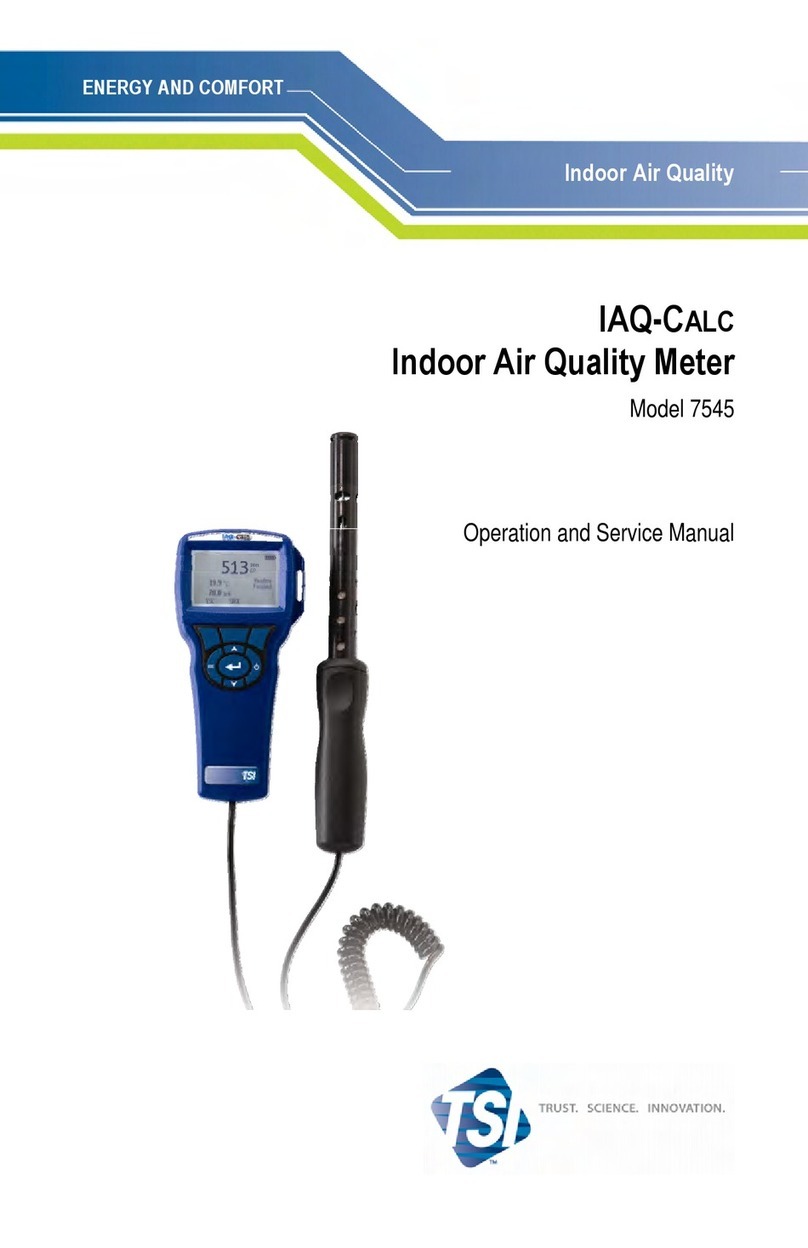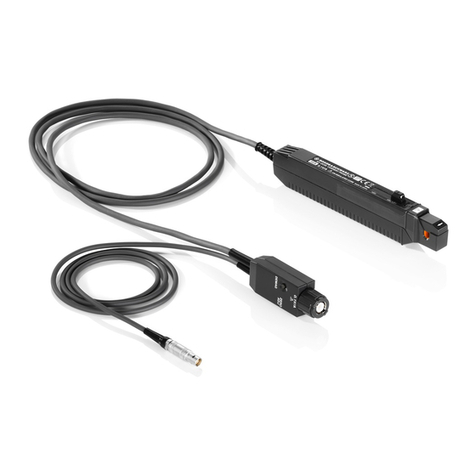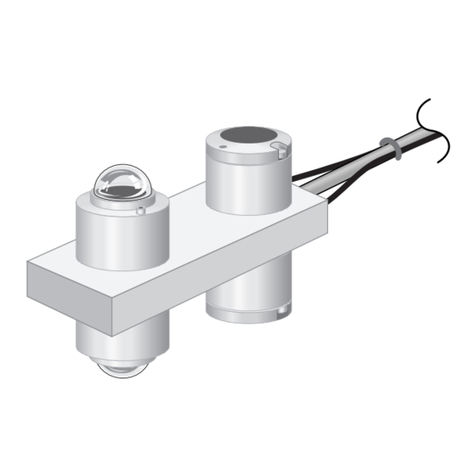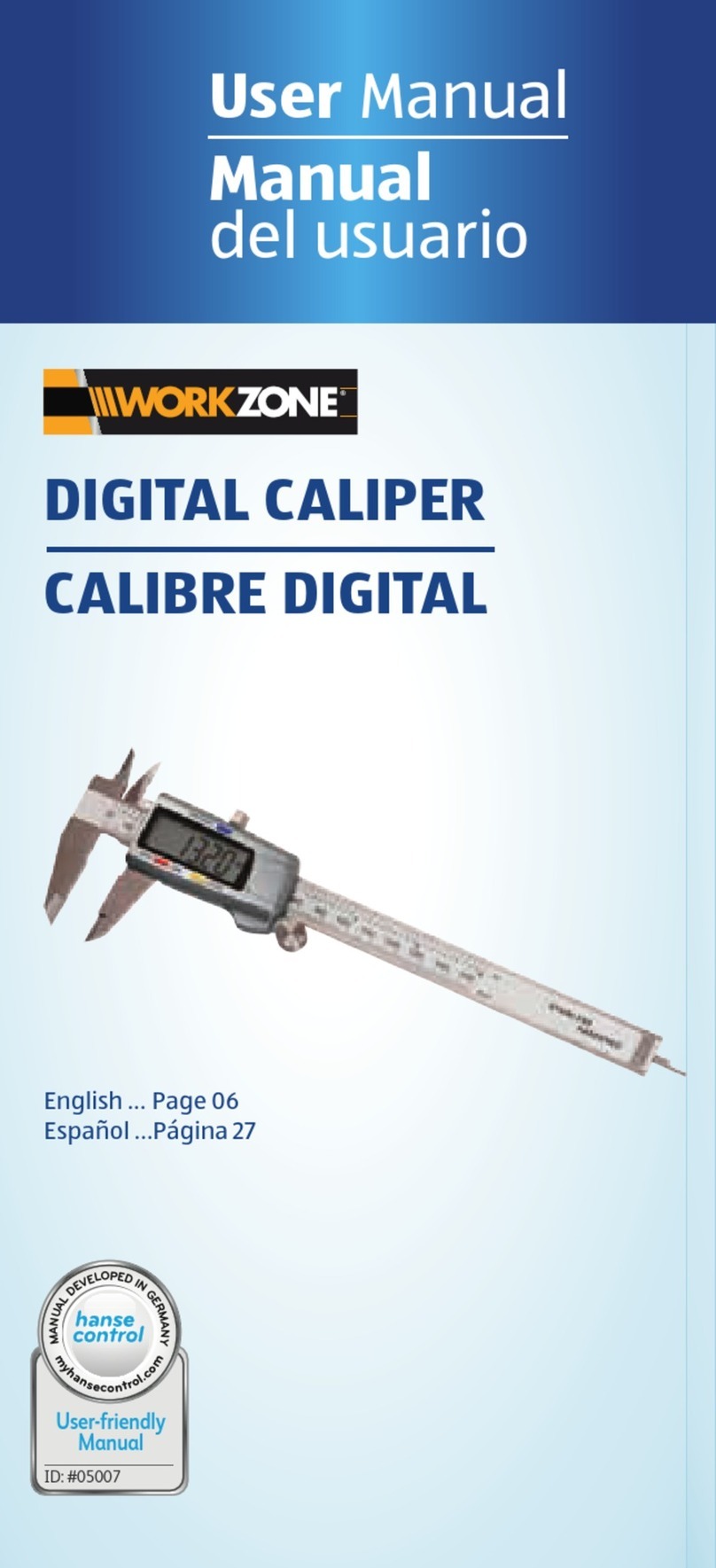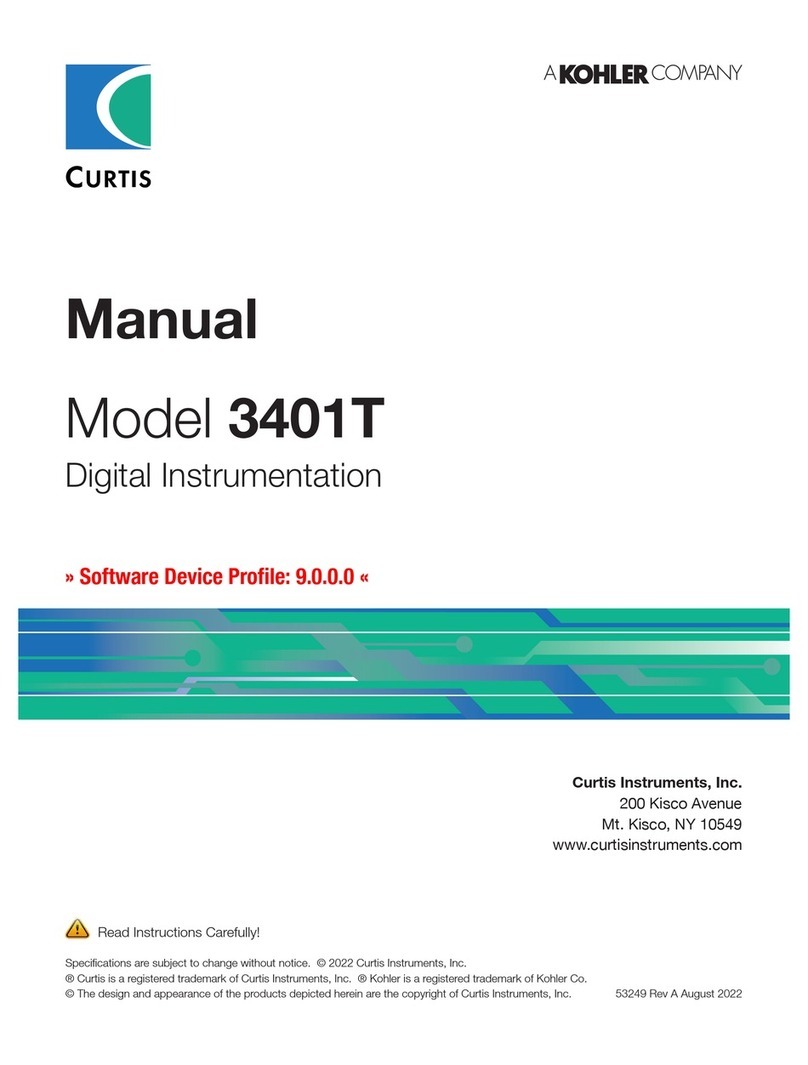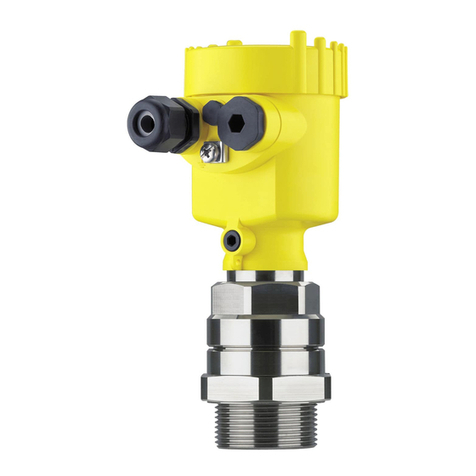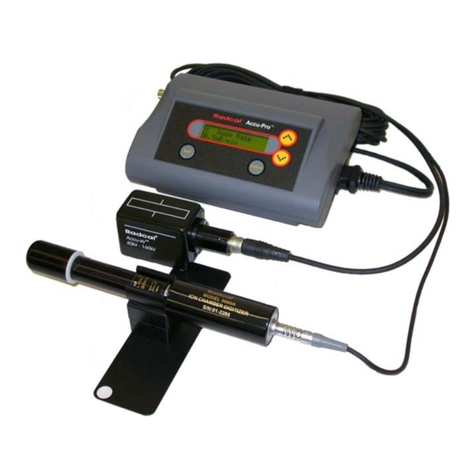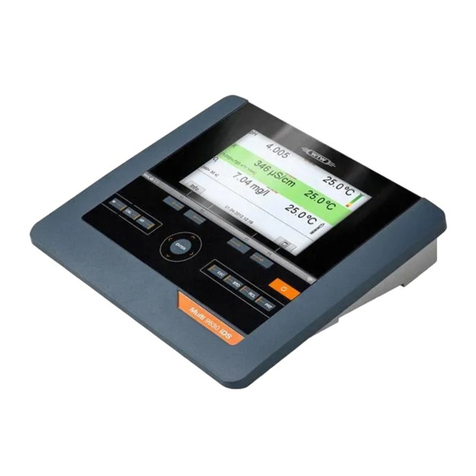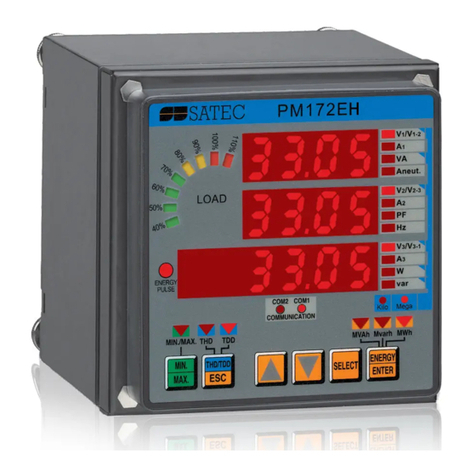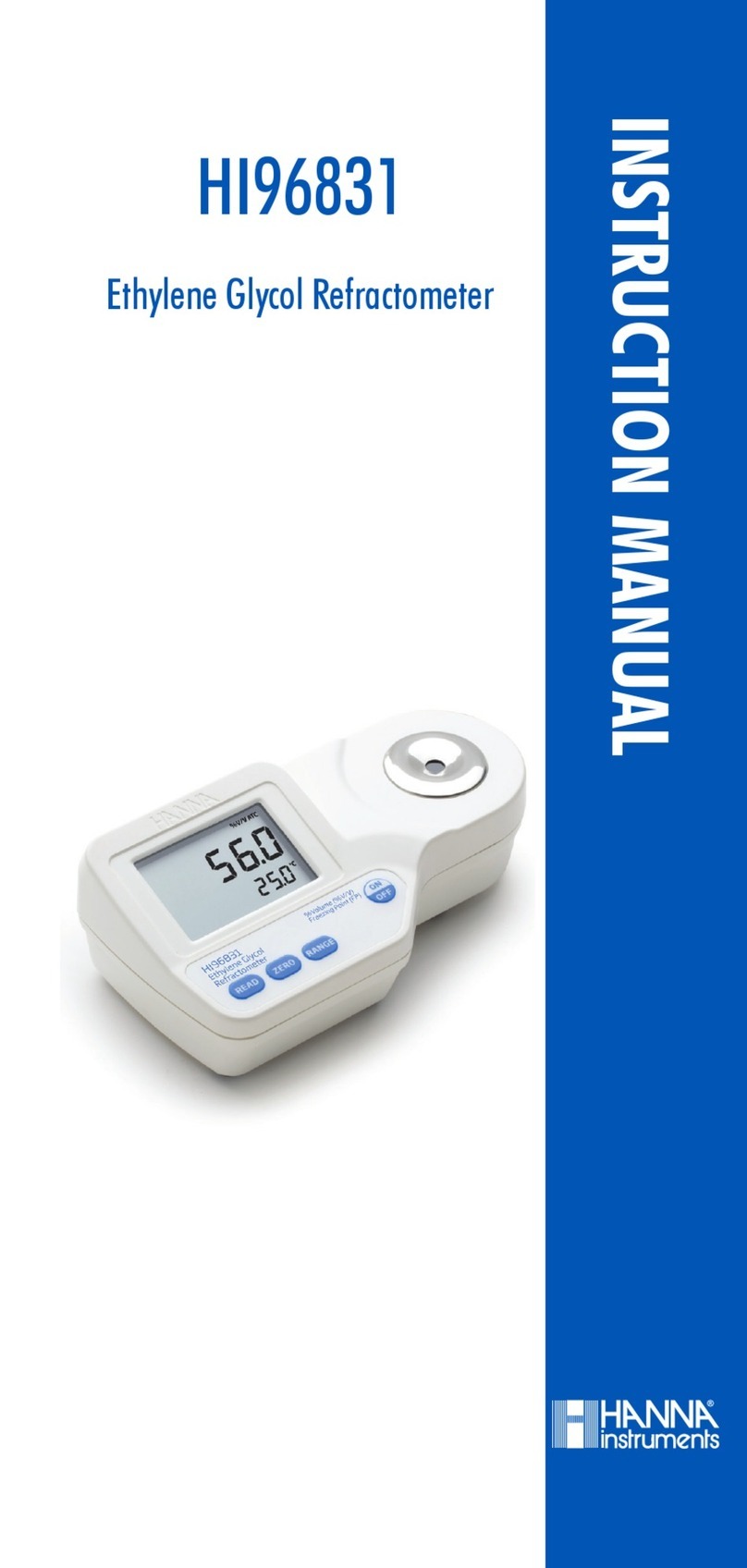GOK GWG User instructions

Originalanleitung / Artikel-Nr. 15 382 80 b
Ausgabe 04.2017 /Ersatz für Ausgabe 10.2015
Beschreibung und CE-Kennzeichnung
Grenzwertgeber GWG - Typ GWS - Heft 1
Gültig nur mit Heft 2: Montage- und Bedienungsanleitung
mit montierter
Rohrarmatur Typ 904
grau oder gelb
mit höhenverstellbarer
Rohrarmatur Typ 904
grau oder gelb
mit loser
Wandarmatur Typ 905
grau oder gelb
INHALTSVERZEICHNIS
ZU DIESEM PRODUKT ........................................................................................................................... 1
GEEIGNETE TANKS ...............................................................................................................................2
FUNKTIONSBESCHREIBUNG................................................................................................................ 2
ALLGEMEINE PRODUKTINFORMATION ............................................................................................... 3
QSS UND ASS.........................................................................................................................................4
AUFBAU ..................................................................................................................................................5
FÜLLHÖHEN NACH EN 13616................................................................................................................ 6
EINSTELLMAß X..................................................................................................................................... 7
EINSTELLMAß X - NACHTRÄGLICHE LECKSCHUTZAUSKLEIDUNG -
DECKENVERSTEIFUNGSPROFIL.......................................................................................................... 8
EINSTELLMASS X FÜR TANKS, DIE KEINER BAUNORM ENTSPRECHEN.......................................... 8
AUSTAUSCH VON GRENZWERTGEBERN (TANKS ÄLTERER BAUART)........................................... 10
TECHNISCHE ÄNDERUNGEN HEFT 1................................................................................................. 10
LEISTUNGSERKLÄRUNG..................................................................................................................... 11
KONFORMITÄTSERKLÄRUNG............................................................................................................. 11
NOTIZEN............................................................................................................................................... 12
ZU DIESEM PRODUKT
Der Grenzwertgeber Typ GWS ist eine Sicherheitseinrichtung gegen Überfüllen des Tanks
bei der Befüllung in Verbindung mit der Abfüllsicherung am Straßentankfahrzeug.
An Anlagenbetreiber
Lassen Sie sich bitte von Ihrem Fachbetrieb den ordnungsgemäßen
Einbau des Grenzwertgebers (Muster Einbaubescheinigung siehe Heft 2) bestätigen.
Alle Hinweise von Heft 1 und Heft 2 müssen vom Fachbetrieb und vom Betreiber beachtet,
eingehalten und verstanden werden.
Lesen Sie diese Anleitung sorgfältig, bevor Sie das Produkt montieren oder in
Betrieb nehmen!

Grenzwertgeber GWG - Typ GWS - Heft 1
2 / 12 Artikel-Nr. 15 382 80 b
GEEIGNETE TANKS
Der Grenzwertgeber darf in folgende ober- und unterirdische, im Freien, im Innen- und
Außenbereich aufgestellte Tanks eingebaut und verwendet werden:
Tabelle1: Grenzwertgeber Typ GWS für Tanks
Tanks
nach Norm
oberirdische Batterietanks
DIN 6620
oberirdische zylindrische liegende Tanks aus
Stahl
DIN 6616, DIN 6617, DIN 6624-1,
DIN 6624-2, ÖNORM C 2115,
ÖNORM C 2118, EN 12285-2,
unterirdische zylindrische liegende Tanks aus
Stahl
DIN 6608-1, DIN 6608-2, EN 12285-1,
ÖNORM C 2110
standortgefertigte Tanks aus Stahl für die
oberirdische Lagerung
DIN 6625-1, DIN 6625-2, ÖNORM C 2117
zylindrische stehende Tanks aus Stahl
DIN 6618-1, DIN 6618-2,
DIN 6618-3, DIN 6619-1, DIN 6619-2,
DIN 6623-1, DIN 6623-2,
ÖNORM C 2116
Tanks
NBN I 03-002, NBN I 03-003, NBN I 03-004
oberirdische zylindrische Flachboden-
Tankbauwerke aus metallischen Werkstoffen
DIN 4119-1, EN 1993-4-2, EN 14015
ortsfeste drucklose Tanks aus Thermoplasten
EN 13341, EN 13575
oberirdische GFK-Tanks
EN 13121 Teil 1 bis 4
andere Tanks
mit bauaufsichtlichen
Verwendbarkeitsnachweis
Die Verwendbarkeitsnachweise der Tanks, z. B. zu zulässigen Betriebsmedien sind zu
beachten.
Weitere Einsatzbereiche
•Brennstofftanks im Sinne der RheinSCHUO "Rheinschiffuntersuchungsordnung".
•Kraftstofftanks für Wasserfahrzeuge im Sinne des Arbeitsblattes DWA-A 783
„Betankungsstellen für Wasserfahrzeuge“.
•Grenzwertgeber in Kraftstofftanks von Fahrzeugen.
FUNKTIONSBESCHREIBUNG
Grenzwertgeber GWG Typ GWS
Das Überfüllen der Tanks für flüssige Brenn- und Kraftstoffe muss nach den Vorschriften zum
Schutz der Gewässer vor Verunreinigungen verhindert werden. Diese grundlegende
Anforderung ist erfüllt, wenn Straßentankfahrzeuge mit einer Abfüllsicherung (EN 13616:
Steuereinrichtung am Straßentankfahrzeug) ausgerüstet sind, die im Zusammenwirken mit
einem nach Arbeitsblatt DWA-A 779, DWA-A 791-1, DIN 4755 bzw. VdTÜV-Merkblatt
Tankanlagen 964 vorgeschriebenen Grenzwertgeber ein Überfüllen der Tanks selbsttätig
verhindert.
Die Grenzwertgeber der Baureihe GWG erfüllen die Anforderungen der harmonisierten
EN 13616 als Sensoren für Tanks mit Stromschnittstelle als Teil einer Überfüllsicherung der
Bauart B1 und entsprechen in ihrem Aufbau der zurückgezogenen TRbF 511.
GOK-Grenzwertgeber erfüllen sowohl die Beschaffenheitsanforderungen der EN 13616 als
auch der TRbF 511.

Grenzwertgeber GWG - Typ GWS - Heft 1
Artikel-Nr. 15 382 80 b 3 / 12
Die Funktion des Grenzwertgebers ist nur in Verbindung mit der Abfüllsicherung des
Straßentankfahrzeuges gewährleistet. Die Verwendbarkeitsnachweise der
Abfüllsicherung sind ebenfalls zu beachten und einzuhalten.
Die Grenzwertgeber der Baureihe GWG erfüllen bereits die Anforderungen der EN 13616-2
"Überfüllsicherung für ortsfeste Tanks für flüssige Brenn- und Kraftstoffe — Teil 2:
Überfüllsicherungen ohne Schließeinrichtung" in Verbindung mit EN 16657 "Tanks für die
Beförderung gefährlicher Güter - Transporttankausrüstung für Überfüllsicherungen für
ortsfeste Tanks".
Der Grenzwertgeber Typ GWS entspricht den Anforderungen für Geräte und Schutzsysteme
zur bestimmungsgemäßen Verwendung in explosionsgefährdeten Bereichen nach der
ATEX-Richtlinie 2014/34/EU.
Einbau zulässig in
Ex-Zone
Kennzeichnung
Ex II 1/2G Ex ia IIB T4 Ga/Gb
Grenzwertgeber
1
Sondenrohr mit Sensor
+ siehe Heft 1; Tabelle 3
0
Besondere Bedingungen
•Der Grenzwertgeber Typ GWS darf nicht in der Nähe stark ladungserzeugender Prozesse
eingesetzt werden.
•Das metallische Gehäuse des Einbaukörpers muss in das Erdungskonzept der Anlage mit
einbezogen werden.
•Die Sensor-Schutzhaube ist nicht elektrisch leitfähig mit dem Einbaukörper verbunden und
besitzt eine Kapazität von 21 pF. Diese Gefahr der elektrostatischen Aufladbarkeit muss bei
der Installation und im Betrieb berücksichtigt werden.
ALLGEMEINE PRODUKTINFORMATION
Tabelle 2: Ausführungen Typ GWS (Sondenlänge Z= 400 mm beispielhaft)
Anschlusseinrichtung direkt am Sondenrohr
Rohrarmatur 904
Rohrarmatur 907 (Messing)
in Teleskop-
Ausführung
in Teleskop-
Ausführung
wahlweise mit QSS und ASS

Grenzwertgeber GWG - Typ GWS - Heft 1
4 / 12 Artikel-Nr. 15 382 80 b
Anschlusseinrichtung direkt neben Füllrohrverschluss
Wandarmatur 905
Wandarmatur 905/ 907 (Messing)
Sondenlänge Z
verstellbar
Sondenlänge Zfest
eingestellt
wahlweise mit QSS und ASS
QSS UND ASS
QSS - Qualitäts-Sicherungs-System
Der Grenzwertgeber kann mit einer codierten Anschlusseinrichtung ausgerüstet werden.
Jedem Betriebsmedium ist ein bestimmter Code zugeordnet. Dieser wird über das Steckerteil
der Abfüllsicherung des Straßentankfahrzeuges ausgelesen. Die Freigabe zum Befüllen wird
nur dann erteilt, wenn das Betriebsmedium im Tank des Straßentankfahrzeuges mit dem
bereits vorhandenen Betriebsmedium im Tank übereinstimmt. Die Codierung erfolgt über den
Flanschsteckereinsatz:
Code 1: Ottokraftstoff/Benzin Super bleifrei
Code 2: Dieselkraftstoff
Code 3: Ottokraftstoff/Benzin Normal bleifrei
Code 4: Ottokraftstoff/Benzin Super Plus bleifrei
Code 5. Heizöl (nur AT)
ASS - Abfüll-Schlauch-Sicherung
Zusätzlich zu dem QSS-Code kann die Anschlusseinrichtung für eine Schlauchüberwachung
benutzt werden. Ein Signal wird über das Verbindungskabel vom Schaltverstärker der
Abfüllsicherung zum Grenzwertgeber geleitet und über die Schläuche zurück zum
Schaltverstärker geführt. Nur wenn der Füllschlauch (bei Ottokraftstoffen zusätzlich der
Gaspendelschlauch) sicher angeschlossen ist, kann eine Befüllung erfolgen. Die Codierung
erfolgt über den Flanschsteckereinsatz.

Grenzwertgeber GWG - Typ GWS - Heft 1
Artikel-Nr. 15 382 80 b 5 / 12
Sondenlänge
Realisierbare Sondenlänge Z= 100 ÷ 3000 mm
Beim Einbau ist folgendes zu beachten:
•GWG mit Sondenrohrlängen Zbis 300 mm: Die Kerbe und der Wert für Zmuss nach
Einbau erkennbar sein.
•GWG mit Sondenrohrlängen Z= 1000 ÷ 3000 mm: Das aus dem Tank herausragende
Sondenrohr ist gegen mechanische Beanspruchungen zu schützen.
Teleskoplänge
Nutzbare Länge = (170 ÷ 600) mm bzw. (170 ÷ 760) mm je nach Sondenlänge
Teleskop:
Sondenlänge 700 mm + Teleskop 170 ÷ 600 mm
Sondenlänge 1000 mm + Teleskop 170 ÷ 760 mm siehe Heft 2
AUFBAU
Tabelle 3: Grundaufbau und Begriffe Grenzwertgeber Typ GWS
mit Rohrarmatur 904 und
Einbaukörper G 1,
z. B. Z = 400 mm
Teleskop-Ausführung mit
Rohrarmatur 904 und
Einbaukörper G 1,
z. B. Z = 400 mm
mit loser Wandarmatur 905
und Einbaukörper G 1,
z. B. Z = 400 mm
Anschlusseinrichtung, Verschlusskappe
Anschlusseinrichtung, Stecker
Sondenlänge in mm, dauerhaft
eingeprägt
Kerbe als Markierung für Sondenlänge
Feststellschraube Teleskop
Einbaukörper
Sondenrohr
Sensor
Sensor-Schutzhaube

Grenzwertgeber GWG - Typ GWS - Heft 1
6 / 12 Artikel-Nr. 15 382 80 b
FÜLLHÖHEN NACH EN 13616
Tabelle 4: Füllhöhen
Der Grenzwertgeber besteht aus einem höhenverstellbaren
Sondenrohr. Der GWG wird mit einem Einbaukörper
senkrecht in den Tank eingebaut. Angeschlossen wird die
Verbindungsleitung der Überfüllsicherung am
Straßentankfahrzeug über eine Anschlusseinrichtung.
Füllhöhe L
1
Bei dieser Höhe wird die Befüllung unterbrochen oder stark
verringert. Die Füllhöhe wird so eingestellt, dass bei der
Entleerung des Straßentankfahrzeuges und der Füllleitung die
Füllhöhe L2nicht überschritten wird. Füllhöhe L1ist das
Bezugsmaß für das Einstellmaß X.
Füllhöhe L
2
Bei dieser Höhe wird jede weitere Zufuhr von Betriebsmedium
beim Befüllen eines Tanks vor oder bei Erreichen der
maximalen Füllhöhe Lmax des Grenzwertgebers verhindert.
Zulässige Füllhöhe L
max
Höhe bei zulässigem Füllungsgrad nach Tabelle 5.
Markierungen auf dem Grenzwertgeber
Der Grenzwertgeber ist mit zwei Markierungen versehen:
•Sondenlänge Zin mm, dauerhaft eingeprägt, mit Kerbe,
muss nach dem Einbau erkennbar sein
•Ansprechpunkt des Fühlers bei L1.
Das aus dem Tank herausragende Sondenrohr
ist gegebenenfalls gegen mechanische Beanspruchungen,
z. B. Druck, Stoß oder Erschütterungen, zu schützen.
KONTROLLMASS Y = Z - X
Abstand zwischen oberer Markierung für Zund oberer Bezugskante Tank.
Funktionsweise eines Grenzwertgebers
Für die Funktion eines Grenzwertgebers wird das Prinzip eines temperaturab-
hängigen elektrischen PTC-Widerstandes - auch Kaltleiter oder Sensor genannt -
genutzt. Mit dem Widerstand des Kaltleiters stellt sich ein Strom ein.
Ist der GWG mit der Steuereinrichtung der Abfüllsicherung am Straßentankfahr-
zeug beim Füllvorgang über ein Kabel verbunden, wird dieser mit Spannung
beaufschlagt. Der Kaltleiter heizt auf. Durch die Temperaturänderung erfolgt das
Freigabesignal und die Steuereinrichtung öffnet das Absperrventil am
Straßentankfahrzeug. Sobald die austretende Flüssigkeit den Kaltleiter bei
Füllhöhe L1im Tank berührt, kühlt der Kaltleiter ab und der elektrische
Widerstand ändert sich. Diese Widerstandsänderung bewirkt eine Stromänderung
im GWG-Stromkreis. Dadurch beendet die Steuereinrichtung den Füllvorgang
sofort durch Schließen des Absperrventils am Straßentankfahrzeug.
Die Befüllung ist spätestens beim Erreichen des zuvor vom
Straßentankfahrer ermittelten maximal zulässigen Abgabevolumens zu beenden!
Eine vorsätzliche Befüllung bis zur Abschaltung durch den Grenzwertgeber bei Erreichen des
zulässigen Füllungsgrades ist unzulässig.

Grenzwertgeber GWG - Typ GWS - Heft 1
Artikel-Nr. 15 382 80 b 7 / 12
Befüllung und Gewässerschutz in Deutschland
Nach § 2 „Besondere Pflichten beim Befüllen und Entleeren“ der Verordnung über Anlagen
zum Umgang mit wassergefährdenden Stoffen vom 31. März 2010 gilt ebenfalls:
„Wer eine Anlage zum Lagern wassergefährdender Stoffe befüllt oder entleert, hat diesen
Vorgang zu überwachen und sich vor Beginn der Arbeiten vom ordnungsgemäßen Zustand
der dafür erforderlichen Sicherheitseinrichtungen zu überzeugen. Die zulässigen
Belastungsgrenzen der Anlagen und der Sicherheitseinrichtungen sind beim Befüllen oder
Entleeren einzuhalten.“
EINSTELLMAß X
Den Tabellen der Montage- und Bedienungsanleitung Heft 2 für das Einstellmaß Xliegt eine
Füllhöhe L1für die Länge der Füllleitung bis 20 m zu Grunde. Die Füllhöhe L1 ist das
Bezugsmaß für X.
Ist die Füllleitung an der Anlage zum Lagern, Abfüllen und Umschlagen von
wassergefährdenden Stoffen länger als 20 m, muss die Füllhöhe L1verringert werden:
Kriterium:
•Nachlaufmenge in der Füllleitung
•das Einstellmaß Xist nach den besonderen Verhältnissen neu zu bestimmen
•der zulässige Füllungsgrad mit Lmax von Tanks nach Tabelle 5 darf nicht überschritten
werden, z.B.Füllstandsmarke-Maximum am Tank bzw. auf dem Füllstandsanzeiger
Tabelle 5: Zulässiger Füllungsgrad bei Lmax von Tanks für Brenn- und Kraftstoffe
Zulässiger
Füllungsgrad 6)
Tank
Brennstoff
Kraftstoff
Erddeckung
Oberirdisch
Unterirdisch 5)
90 % (V/V) 7)
X
X
X
---
95 % (V/V)
X
X
X
---
X
X
X
< 0,3 m
1) 2) 4)
X
X
X
< 0,8 m
3) 10)
X
X
X
k. A.8)
97 % (V/V)
X
X
X
≥0,3 m
1) 2) 4)
X
X
X
≥0,8 m
3) 10)
98 % (V/V)
X
X
X
9)
1)
Nur bei Brennstoffen mit einem räumlichen Wärmeausdehnungskoeffizient β≤ 85 • 10-5/K,
z. B. Heizöl EL
2)
Nur bei Kraftstoffen mit einem räumlichen Wärmeausdehnungskoeffizient β≤ 85 • 10-5/K,
z. B. Dieselkraftstoff
3)
Nach DIN 4755
4)
Nach TRÖl Auflage 2.0 und DWA-A 791-1 (TRwS)
5)
Nur Typ GWS
6)
Max. zulässiges Lagervolumen < tatsächliches Volumen des Tanks
7)
Tanks in Schienenfahrzeugen nach EN 45545-7
8)
Gilt in Österreich für Tanks, nach TRÖL 3. Auflage
9)
Gilt in Belgien
10)
Nach VdTÜV-Merkblatt Tankanlagen 967
In Deutschland galt / gilt nach TRbF 20:
Für Tanks zur Lagerung brennbarer Flüssigkeiten mit giftigen oder ätzenden Eigenschaften
soll ein mindestens 3 % niedrigerer Füllungsgrad eingehalten werden.

Grenzwertgeber GWG - Typ GWS - Heft 1
8 / 12 Artikel-Nr. 15 382 80 b
EINSTELLMAß X - NACHTRÄGLICHE LECKSCHUTZAUSKLEIDUNG -
DECKENVERSTEIFUNGSPROFIL
Bei einem nachträglichen Einbau einer Leckschutzauskleidung in einen Tank verringert sich
sein tatsächliches Volumen und damit die Füllhöhe L1und Lmax. In den bauaufsichtlichen
Verwendbarkeitsnachweisen von Leckschutzauskleidungen des DIBt ist vermerkt, das nach
deren Einbau das Einstellmaß Xm.LSA vom ausführenden Fachbetrieb oder von einem
Sachverständigen nach Wasserrecht neu zu bestimmen und der Grenzwertgeber
entsprechend einzustellen ist.
Der TÜV Nord empfiehlt, das vorgegebene Einstellmaß Xdes Grenzwertgebers für den
Einbau in einen Tank mit Leckschutzauskleidung um 30 mm zu erhöhen.
Es gilt dann für das korrigierte Mindest-Einstellmaß: Xm.LSA = X+ 30 mm mit X in [mm]
Tanks nach DIN 6625 mit innen versteiften Tankdecken:
•Der Grenzwertgeber ist so anzuordnen, dass dieser sich zusammen mit dem Be- und
Entlüftungsstutzen in einem Deckenfeld, also zwischen zwei innen liegenden
Deckenverstärkungsprofilen, befindet: Das Einstellmaß Xmuss um die Höhe des
Deckenversteifungsprofils (Trägers), mindestens jedoch 30 mm erhöht werden.
•je nach Ausführung der Abpolsterung der Versteifungen können gefährliche Luftsäcke durch
die Polsterung von Trägern im Tank entstehen.
Mindest-Einstellmaß Xm.LSA ≥X+ 100 mm mit Xin [mm
EINSTELLMASS X FÜR TANKS, DIE KEINER BAUNORM ENTSPRECHEN
In diesem Fall ist eine Einzelabnahme notwendig. Die Vorgehensweise ist mit der
zuständigen Behörde (z. B. für Deutschland Untere Wasserbehörde) oder eines
Sachverständigen/ befähigte Person (in Deutschland nach VAwS / AwSV) abzustimmen.
Möglichkeit 1
Verwendung eines Grenzwertgebers, der dem bisher eingebauten entspricht. Fragen Sie bei
dem Tankhersteller, mit Angabe der angebrachten Nummer des bauaufsichtlichen
Verwendbarkeitsnachweises, nach einem Nachfolgemodell.
Zu beachten ist der bauaufsichtliche Verwendbarkeitsnachweis des Grenzwertgebers für die
jeweilige Tankform, das Einstellmaß Xund das Anschlussgewinde des Einbaukörpers. Das
Einstellmaß Xfür den neuen Grenzwertgeber kann übernommen werden.
Möglichkeit 2
Bei einem völlig entleerten Tank kann das Einstellmaß durch sogenanntes „Auslitern“
bestimmt werden. Das „Auslitern“ ist ein experimentelles Verfahren, um eine Peiltabelle zu
erstellen. Dazu wird der völlig entleerte Tank schrittweise gefüllt und das Volumen sowie die
dazugehörige Füllhöhe (z. B. durch einen Meterstab) erfasst.
Möglichkeit 3
Von dem zulässigen Füllungsgrad L1, wird die ermittelte Nachlaufmenge abgezogen. Aus der
Differenz wird mit Hilfe einer Peiltabelle oder durch Berechnung des Volumens für den Tank
die Füllhöhe L1ermittelt.
Folgende Berechnung nach Tabelle 6 basiert auf TRbF 510, ZG-ÜS des DIBt,
VdTÜV-Merkblatt Tankanlagen 967 und EN 13616-2:2016.

Grenzwertgeber GWG - Typ GWS - Heft 1
Artikel-Nr. 15 382 80 b 9 / 12
Tabelle 6: Berechnungsmöglichkeit für das Einstellmaß X
a = Maß a= H - L
1
- b
b = Tankwanddicke
H = Höhe oder Durchmesser des Tanks
k = Höhe Muffe oder Gewindeflansch
1. Maximale Volumenstrom der Förderpumpe des
Straßentankfahrzeuges
Q
max
l/min
2. Schalt- und Schließverzögerungszeiten der Förderpumpe
des Straßentankfahrzeuges
Zeit
Standaufnehmer laut Messung/ Datenblatt
t1
s
Schalter/ Relais/ u. ä.
t2
s
Förderpumpe, Auslaufzeit
t3
s
Absperrarmatur:
•mechanisch, handbetätigt Zeit Alarm bis Schließbeginn, Schließzeit:
•elektrisch, pneumatisch oder hydraulisch betrieben, Schließzeit:
t
4
s
s
Gesamtzeit (tges= t1+ t2+ t3+ t4):
tges
s
3. Nachlaufvolumen V4
Nachlaufvolumen aus Verzögerungszeiten:
V1= Qmax •(tges/60)
V
1
L
Nachlaufvolumen aus Füllleitung:
V2= (π/ 4) • Di² • LFL/1000
Di= Rohrinnendurchmesser in [mm
LFL = Länge der Füllleitung in [m]
V2L
V4= V1+ V2
V4
L
4. Füllhöhe L1
Volumen bei zulässigem Füllungsgrad nach Tabelle 1 von Heft 1
V3
L
Nachlaufvolumen
V4
L
Volumen bei Füllhöhe L1V5= V3- V4
V5
L
Aus dem Volumen bei Füllhöhe V
5
ergibt sich dann aus der Peiltabelle oder durch
Berechnung die Füllhöhe L1.
Das Einstellmaß Xfür den GWG ist unter Berücksichtigung* der Tankform zu bestimmen:
Einbau auf Tankdecke:
X = H - L1- b
= mm
*Ggf. EINSTELLMASS X – NACHTRÄGLICHE LECKSCHUTZAUSKLEIDUNG –
DECKENVERSTEIFUNGSPROFIL berücksichtigen.

Grenzwertgeber GWG - Typ GWS - Heft 1
10 / 12 Artikel-Nr. 15 382 80 b
Tabelle 7: Beispiel für die Berechnung des Einstellmaßes X
Länge = 1010 mm Breite = 1010 mm Höhe H = 1010 mm b = 5 mm,
Nennvolumen des Tanks = 1000 l Muffe mit k = 30 mm GWG mit Z = 305 mm
1. Qmax nach DIN 4755, DWA-A 791-1 und TRbF 20
1200 l/min
2. Gesamtzeit tges nach EN 13616
5,5 s
3. Nachlaufmenge V3
V1= 1200 l/min; (5,5 s • min/ 60 s)
110 l
V2für Di= 55 mm und LFL = 15 m
35 l
V4= V1+ V2= 110 l + 35 l
145 l
4. Ansprechhöhe L1und Einstellmaß X
V3= 95 % (V/V) von 1000 l
950 l
V5= V3- V4= 950 - 145
805 l
a) In Peiltabelle Volumen V5suchen und Füllhöhe L1entnehmen
_ _ _ _ mm
b) Ansatz: L
1
+ a - b = H - (2 • b) = 1000 mm
1000 l ≡1000 mm bei 100 % (V/V), 805 l ≡ L1[mm]
c) aus a) oder b): L1= 805 mm
d) Einstellmaß GWG X = H - L1- b + k = 1010 - 805 - 5 + 30
230 mm
e) Kontrollmaß GWG Y = Z - X = 305 - 230
75 mm
AUSTAUSCH VON GRENZWERTGEBERN (TANKS ÄLTERER BAUART)
Aus DIBt-Mitteilungen Heft 1/2008
Beim Austausch von Grenzwertgebern an Tanks mit Prüfbescheiden oder allgemeinen
bauaufsichtlichen Zulassungen dürfen folgende Grenzwertgeber mit bauaufsichtlichen
Verwendbarkeitsnachweis eingebaut werden:
•Grenzwertgeber, die in den vorgesehenen Anschluss am Tank passen,
•Grenzwertgeber, die eine solche Länge haben, mit der das bisherige Einstellmaß wieder
einstellbar und das dazugehörige Kontrollmaß ablesbar ist.
TECHNISCHE ÄNDERUNGEN HEFT 1
Alle Angaben sind die Ergebnisse der Produktprüfung und entsprechen dem derzeitigen
Kenntnisstand sowie dem Stand der Gesetzgebung und der einschlägigen Normen zum
Ausgabedatum. Änderungen der technischen Daten, Druckfehler und Irrtümer vorbehalten.
Alle Abbildungen dienen illustrativen Zwecken und können von der tatsächlichen Ausführung
abweichen.

Grenzwertgeber GWG - Typ GWS - Heft 1
Artikel-Nr. 15 382 80 b 11 / 12
LEISTUNGSERKLÄRUNG
Die Leistungserklärung vom Hersteller für dieses Produkt
erhalten Sie im Internet unter: http//www.gok-online.de/de/
zertifikate/leistungserklaerungen.php
•CE-Kennzeichnung nach EU-BauPVO: Leistungserklärung nach EN 13616
BAUMUSTERPRÜFBESCHEINIGUNG
Die Baumusterpruefbescheinigung vom Hersteller für dieses Produkt erhalten
Sie im Internet unter:
http//www.gok-online.de/de/zertifikate/baumusterpruefbescheinigungen.php
•CE-Konformität nach ATEX mit Baumusterprüfbescheinigung
ESP 15 ATEX 1 032 X
KONFORMITÄTSERKLÄRUNG
Die Konformitätserklärung vom Hersteller für dieses Produkt erhalten Sie im
Internet unter: http//www.gok-online.de/de/zertifikate/
konformitaetserklaerungen.php
•CE-Konformität nach EMV und RoHS
•Bauprodukt für Überschwemmungs- und Risikogebiete
•Belgien: AIB-VINCOTTE mit Prototyp-Nr. 99/H031/03060501

Grenzwertgeber GWG - Typ GWS - Heft 1
Regler- und Armaturen-Gesellschaft mbH & Co. KG
Obernbreiter Straße 2-18 • 97340 Marktbreit / Germany
Tel.: +49 9332 404-0 • Fax: +49 9332 404-43
E-Mail: info@gok-online.de • www.gok-online.de • www.gok-blog.de
12 / 12 Artikel-Nr. 15 382 80 b
NOTIZEN

Translation of the original operating instructions / part no. 15 382 64 c
Version 04.2017 /Replaces version 10.2015
Description and CE marking
Limitid indikator GWG - type GWS - issue 1
Only valid inconnection with issue 2,assembly and operating instructions
with mounted pipe
fitting type 904,
grey or yellow
with height-
adjustable pipe
fitting type 904,
grey or yellow
with loose wall
fitting type 905,
grey or yellow
CONTENTS
ABOUT THIS PRODUCT......................................................................................................................... 1
DECLARATION OF PERFORMANCE ................................................................................................... 10
DECLARATION OF CONFORMITY....................................................................................................... 11
SUITABLE TANKS...................................................................................................................................2
FUNCTION DESCRIPTION ..................................................................................................................... 2
GENERAL PRODUCT INFORMATION.................................................................................................... 3
QAS AND FHS......................................................................................................................................... 4
DESIGN................................................................................................................................................... 5
LEVELS ACCORDING TO EN 13616 ...................................................................................................... 6
ADJUSTING DIMENSION X..................................................................................................................... 7
ADJUSTING DIMENSION X AND SUBSEQUENT LEAK PROTECTION LINING .................................... 8
ADJUSTING DIMENSION X FOR TANKS NOT CORRESPONDING TO ANY STANDARD FOR
BUILDING INDUSTRY............................................................................................................................. 8
LIMIT INDICATOR REPLACEMENT (OLDER TANKS).......................................................................... 10
TECHNICAL CHANGES ISSUE 1.......................................................................................................... 10
ABOUT THIS PRODUCT
The type GWS limit indicator is a safety device against overfilling the tank during filling in
combination with the overfill prevention mechanism of the road tanker.
To the system operator
Have your specialised company confirm the proper installation of the limit indicator
(template installation certificate see issue 2).
All instructions included in the issues 1 and 2must be observed, adhered to, and understood
by the specialised company and the operator.
Please read this manual carefully prior to installing or commissioning the
product!

Limitid indikator GWG - type GWS -issue 1
2 / 12 part no. 15 382 64 c
SUITABLE TANKS
The limit indicator may only be installed and used in the following overground and
underground tanks which are constructed indoors and outdoors:
Table1: Type GWS limit indicator for tanks
Tanks
pursuant to standard
above-ground battery tanks
DIN 6620
above-ground cylindrical, horizontal steel
tanks
DIN 6616, DIN 6617, DIN 6624-1, DIN 6624-2,
ÖNORM C 2115,
ÖNORM C 2118, EN 12285-2,
underground cylindrical, horizontal steel
tanks
DIN 6608-1, DIN 6608-2, EN 12285-1,
ÖNORM C 2110
locally manufactured tanks made of steel
for above-ground storage
DIN 6625-1, DIN 6625-2, ÖNORM C 2117
cylindrical, vertical steel tanks
DIN 6618-1, DIN 6618-2,
DIN 6618-3, DIN 6619-1, DIN 6619-2,
DIN 6623-1, DIN 6623-2,
ÖNORM C 2116
Tanks
NBN I 03-002, NBN I 03-003, NBN I 03-004
above-ground cylindrical flat-bottom tank
structures made of metal materials
DIN 4119-1, EN 1993-4-2, EN 14015
stationary pressure-free tanks made of
thermoplastics
EN 13341, EN 13575
above-ground GRP tanks
EN 13121 parts 1 to 4
other tanks
including certificate of suitability for intended
use issued by the building inspectorate
The certificates of suitability for intended use of the tanks, e.g. regarding admissible
operating media, must be observed.
Further fields of application
•Fuel oil tanks in the meaning of RheinSCHUO “Rhine Vessel Inspection Regulation".
•Fuel tanks for vessels in the meaning of the worksheet DWA-A 783 “Fuelling stations for
vessels“.
•Limit indicator in fuel reservoirs of vehicles.
FUNCTION DESCRIPTION
Type GWS limit indicator GWG
In accordance with the regulations for protecting waterways against pollution, overfilling of
tanks used to store liquid fuels must be prevented. This basic requirement is met if road
tankers are equipped with an overfill prevention mechanism (EN 13616: Steuereinrichtung am
Straßentankfahrzeug) automatically preventing the tanks from being overfilled in cooperation
with a limit indicator specified according to worksheet DWA-A 779, DWA-A 791-1, DIN 4755
and VdTÜV leaflet Tank systems 964, respectively.
The GWG series limit indicators meet the requirement according to harmonised
EN 13616 as sensors for tanks with current interface as part of a type B1 overfill protection
device and meet the withdrawn TrbF 511 regarding their design. GOK limit indicators meet
the demands on the condition of both EN 13616 and TrbF 511.

Limitid indikator GWG - type GWS -issue 1
part no. 15 382 64 c 3 / 12
The function of the limit indicator is only guaranteed in combination with the overfill
prevention mechanism of the road tanker. The certificates of suitability for intended
use of the overfill prevention mechanism must be observed and adhered to as well.
The limit indicators for the GWG series already fulfil the requirements of EN 13616-2 “Overfill
prevention device for stationary tanks for liquid fuels — part 2: overfill prevention devices
without closing unit” in connection with EN 16657 “Tanks for the transport of hazardous goods
- transport equipment for overfill prevention devices for stationary tanks.”
The GWS type limit indicator meets the requirements for devices and protective systems for
intended use in potentially explosive areas according to the ATEX Directive 2014/34/EC.
Installation permitted in
Ex protection zone
Marking
Ex II 1/2G Ex ia IIB T4 Ga/Gb
Limit indicator
1
Probe tube with sensor
+ see issue 1, table 3
0
Special conditions
•The GWS type limit indicator cannot be used in proximity to strong charge generating
processes.
•The metallic housing of the insert has to be incorporated in the earthing concept of the
installation.
•The sensor cover is not connected with the insert so that it is electrically conductive and has
a capacity of 21 pF. The danger of electrostatic charging has to be taken into consideration
during the installation and operation.
GENERAL PRODUCT INFORMATION
Table 2: Type GWD designs (exemplary probe length Z = 400mm)
Connector directly on the probe tube
Pipe fitting 904
Pipe fitting 907 (brass)
in telescopic design
in telescopic design
optionally with QAS and FHS

Limitid indikator GWG - type GWS -issue 1
4 / 12 part no. 15 382 64 c
Connector directly next to filling hole plug
Wall fitting 905
Wall fitting 905 / 907 (brass)
Probe length Z adjustable
Probe length Z fixed
optionally with QAS and FHS
QAS AND FHS
QAS - Quality Assurance System
The limit indicator can be equipped with a coded connector. A specific code is assigned to
every operating medium. This is read out via the connector part of the overfill prevention
mechanism of the road tanker. The approval for the filling is only provided if the operating
medium in the tank of the road tanker corresponds with the existing operating medium in the
tank. The encoding takes place with the flange plug insert:
Code 1: petrol/super unleaded petrol
Code 2: diesel
Code 3: petrol/regular unleaded petrol
Code 4: petrol/super plus unleaded petrol
Code 5. fuel oil (AT only)
FHS - Filling hose securing
In addition to the QAS code, the connector can also be used in order to monitor a hose.
Asignal is directed via the connection cable of the switching amplifier of the overfill
prevention mechanism tothe limit indicator and back to the switching amplifier via the hoses.
Afilling can only take place if the filling hose assembly (with petrol, the gas displacement
hose as well) is securely connected. The encoding takes place with the flange plug insert.

Limitid indikator GWG - type GWS -issue 1
part no. 15 382 64 c 5 / 12
Probe length
Possible probe length Z= 100 ÷ 3000mm
The following must be observed during installation:
•Limit indicator with probe tube lengths Zup to 300mm: The notch and the value for Z must
be visible upon installation.
•Limit indicator with probe tube lengths Z= 1000 ÷ 3000mm: The probe tube protruding from
the tank must be protected against mechanical loads.
Telescopic length
Usable length = (170 ÷ 600)mm or (170 ÷ 760)mm depending on probe length
Telescope:
Probe length 700mm + telescope 170 ÷ 600mm
Probe length 1000mm + telescope 170 ÷ 760mm See booklet 2
DESIGN
Table 3: Type GWS limit indicator basic design and terms
with pipe fitting 904 and
insert G 1,
e.g. Z = 400mm
Telescopic design with
pipe fitting 904 and
insert G 1,
e.g. Z = 400mm
with loose wall fitting 905
and insert G 1,
e.g. Z = 400mm
Connector, cap
Connector, joint
Probe length in mm, permanently impressed
Notch marking the probe length
Locking screw
Insert
Probe tube
Sensor
Sensor cover
Telescope

Limitid indikator GWG - type GWS -issue 1
6 / 12 part no. 15 382 64 c
LEVELS ACCORDING TO EN 13616
Table 4: Levels
The limit indicator consists of a height-adjustable probe tube.
The GWG is installed vertically into the tank with an insert. The
connection line of the overfill protection device is connected to
the road tanker using a connector.
Level L
1
At this level, the process of filling is interrupted or reduced
significantly. The level is set in such a way that the level L2is
not exceeded when draining the road tanker and the filler line.
Level L1is the reference dimension for the adjusting
dimension X.
Level L
2
Regarding this level, any further addition of operating medium
is prevented when filling the tank prior to or when reaching the
maximum level Lmax of the limit indicator.
Admissible level L
max
Level at admissible level according to table 5.
Marks on the limit indicator
The limit indicator has two marks:
•Probe length Zin mm, impressed permanently, with notch,
must be visible upon installation
•Switching point of the sensor for L1.
If required, the probe tube protruding from the
tank must be protected against mechanical loads, e.g.
pressure, impact, or vibrations.
CONTROL DIMENSION Y = Z - X
Clearance between upper mark for Zand upper reference edge tank.
Mode of operation of a limit indicator
Regarding the function of the limit indicator, the principle of a temperature-
dependent electrical PTC resistor is used - also referred to as PTC thermistor or
sensor. The resistance of the PTC thermistor creates a current.
If, during filling, the GWG is connected to the controller of the overfill prevention
mechanism on the road tanker with the help of a line, the GWG is supplied with
voltage. The PTC thermistor heats. The change in temperature causes the
approval signal and the controller opens the cut-off valve on the road tanker.
Once the escaping liquid makes contact with the PTC thermistor at level L1in the
tank, the PTC thermistor cools down and the electrical resistance changes. This
change in resistance causes a change in current in the GWG circuit. As a
consequence, the controller immediately stops filling by closing the cut-off valve
on the road tanker.
The process of filling shall be terminated at the latest when reaching the
maximum admissible discharge volume previously determined by the road tanker
driver.
It shall be inadmissible to deliberately fill until shutdown by the limit indicator when the
admissible level is reached.

Limitid indikator GWG - type GWS -issue 1
part no. 15 382 64 c 7 / 12
Filling and water control in Germany
According to § 2 “Specific obligations regarding filling and draining” of the Ordinance on
Installations for the Handling of Substances Hazardous to Water (Verordnung über Anlagen
zum Umgang mit wassergefährdenden Stoffen) from 31 March 2010, the following is
applicable additionally:
“The person filling or draining an installation for storing water-hazardous substances shall be
obliged to monitor this process and to make sure, prior to starting any work, that the required
safety equipment is in a proper condition. The admissible exposure limits of the installations
and safety equipment must be adhered to when filling or draining.”
ADJUSTING DIMENSION X
The tables of the manual issue 2 regarding the adjusting dimension Xare based on a level L1
for the length of the filler line to 20m. Level L1is the reference dimension for X.
If, for storing, filling, and handling water-hazardous substances, the filler line on the
installation is longer than 20m, the level L1must be reduced:
Criterion:
•Overrun volume in the filler line
•the adjusting dimension Xmust be re-determined according to the special conditions
•the admissible level with Lmax of tanks according to table 5 must not be exceeded, e.g. level
indicator maximum on the tank and on the level gauge, respectively
Table 5: Admissible level at Lmaxof tanks for fuels
Admissible
level 6)
Tank
Fuel oil
Fuel
Depth
Above-
ground
Underground
5)
90% (V/V)
7)
X
X
X
---
95% (V/V)
X
X
X
---
X
X
X
< 0.3m 1) 2) 4)
X
X
X
< 0.8m
3) 10)
X
X
X
ns
8)
97% (V/V)
X
X
X
≥ 0.3m 1) 2) 4)
X
X
X
≥ 0.8m 3) 10)
98% (V/V)
X
X
X
9)
1)
Only for fuels with a spatial thermal expansion coefficient ß ≤ 85 • 10-5/K, e.g. fuel oil EL
2)
Only for fuels with a spatial thermal expansion coefficient ß ≤ 85 • 10-5/K, e.g. diesel fuel
3)
Pursuant to
DIN 4755
4)
Pursuant to TRÖl edition 2.0 and DWA-A 791-1 (TRwS)
5)
Type GWS only
6)
Maximum admissible storage volume < actual tank volume
7)
Tanks in rail vehicles according to EN 45545-7
8)
Applicable in Austria for tanks, pursuant to TRÖL 3rd edition
9)
Applicable in Belgium
10)
Pursuant to VdTÜV leaflet Tank systems 967
In Germany, the following is/was applicable: pursuant to TRbF 20:
For tanks for storing combustible liquids with toxic or etching properties, a level of at least 3%
less must be complied with.

Limitid indikator GWG - type GWS -issue 1
8 / 12 part no. 15 382 64 c
ADJUSTING DIMENSION X AND SUBSEQUENT LEAK PROTECTION LINING
The subsequent installation of a leak protection lining in a tank reduces the actual tank
volume and therefore the level L1and Lmax. Within the framework of the certificates of
suitability for intended use of leak protection lining issued by the building inspection of the
DIBt, it is stated that, upon installation, the adjusting dimension Xm.LSA must be re-determined
by the executing specialised company or by an expert according to water law and that the
limit indicator must be adjusted accordingly.
TÜV Nord recommends increasing the specified adjusting dimension Xof the limit indicator by
30mm for installation in a tank without leak protection lining.
In this case, the following is applicable to the corrected minimum adjusting dimension:
Xm.LSA = X+ 30mm
with Xin [mm]
Regarding tanks according to DIN 6625 with ceiling braces, dangerous air pockets may be
formed by the padding of beams within the tank, depending on the design of the padding of
the braces. Therefore, a higher value may be required for the adjusting dimension Xm.LSA.
ADJUSTING DIMENSION X FOR TANKS NOT CORRESPONDING TO ANY STANDARD
FOR BUILDING INDUSTRY
These cases require individual acceptance. The approach shall be coordinated with the
competent authority (e.g. in Germany, the lower water authority) or an expert / competent
person (in Germany, according to VAwS).
Option 1
Use of a limit indicator corresponding to the one installed up to date. Ask the tank
manufacturer, stating the attached number of the certificate of suitability for intended use of
the building inspectorate, for the successor model.
The certificate of suitability for intended use of the building inspectorate of the limit indicator
for the respective tank shape, the adjusting dimension X, and the connecting thread of the
insert must be observed. The adjusting dimension Xfor the new limit indicator can be
adopted.
Option 2
Regarding a completely empty tank, the adjusting dimension can be determined by so-called
“volumetric measurement”. “Volumetric measurement” is an experimental process conducted
in order to create a calibration chart. For this, the completely empty tank is filled gradually and
the volume and the related level are determined (e.g. by a folding metre stick).
Option 3
The determined overrun volume is subtracted from the admissible level L1. The difference is
used, together with a calibration chart or by calculating the volume for the tank, to determine
the level L1.
The following calculation according to table 6 is based on TRbF 510, ZG-ÜS of DIBt,
VdTÜV leaflet Tank systems 967 and FprEN 13612-2:2016.
Other manuals for GWG
2
This manual suits for next models
5
Table of contents
Languages:
Other GOK Measuring Instrument manuals

GOK
GOK BC-1 Series User instructions
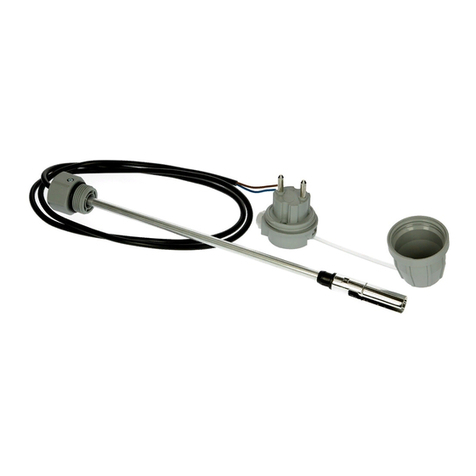
GOK
GOK GWG User instructions
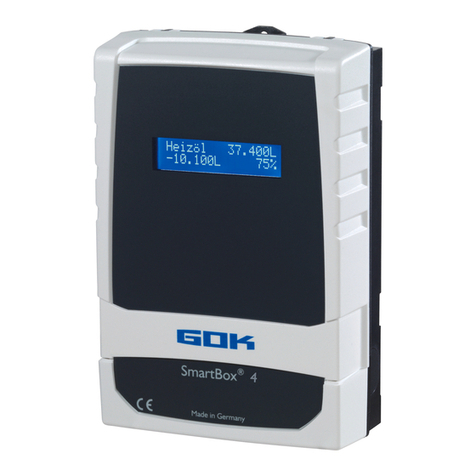
GOK
GOK SmartBox 4 User instructions
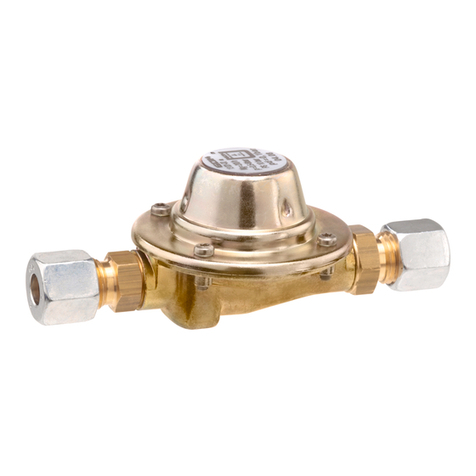
GOK
GOK ODR User instructions
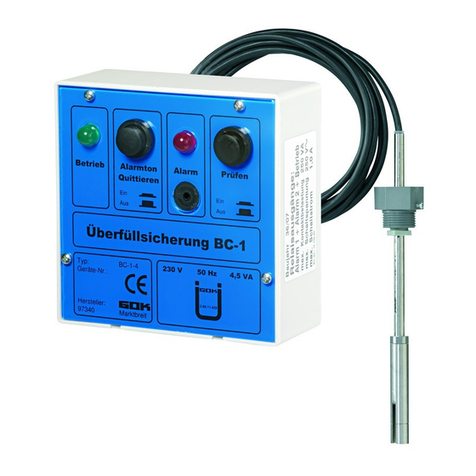
GOK
GOK BC-1 Series User instructions
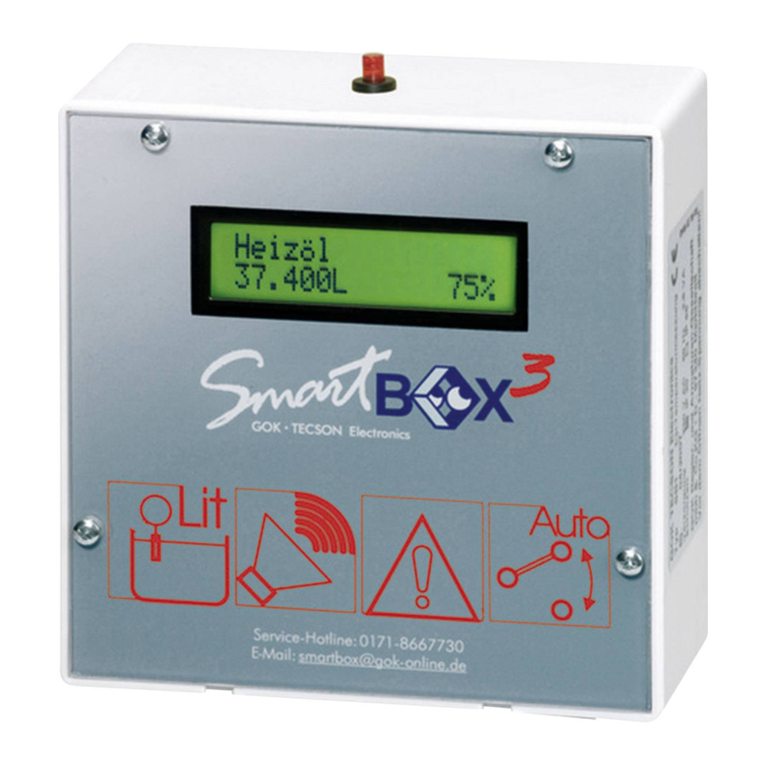
GOK
GOK SmartBox 1 User manual

GOK
GOK SmartBox 4 LAN User instructions

GOK
GOK SmartBox 4 GSM User instructions

GOK
GOK SmartBox 1 User manual

GOK
GOK BC-1-4 User instructions


